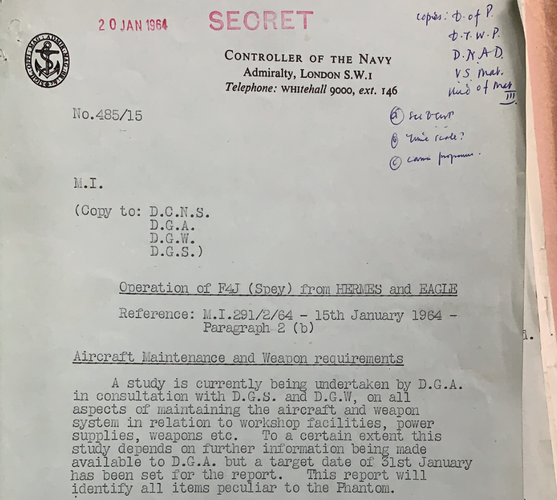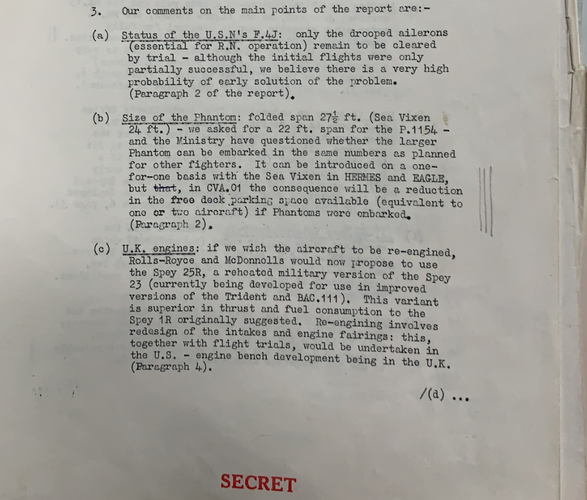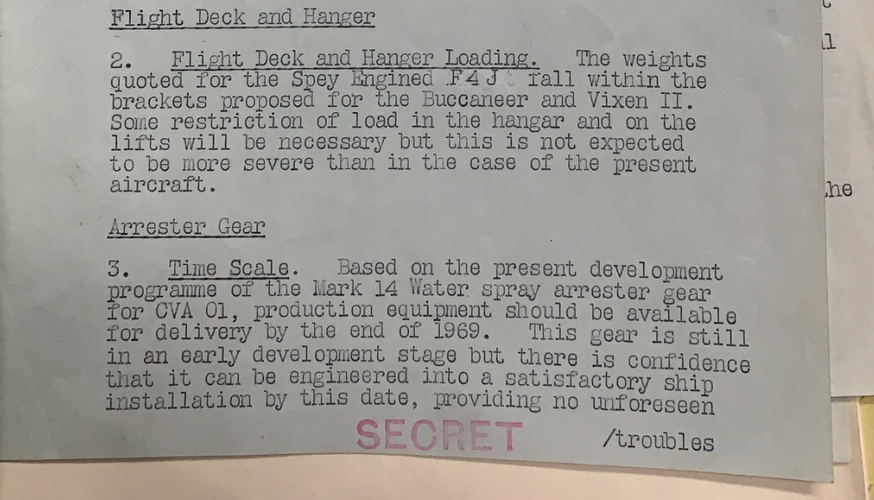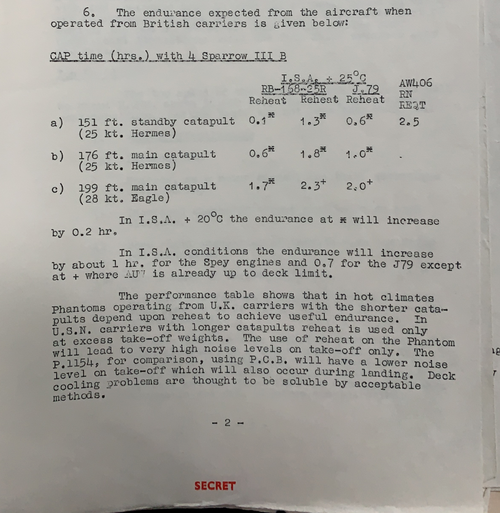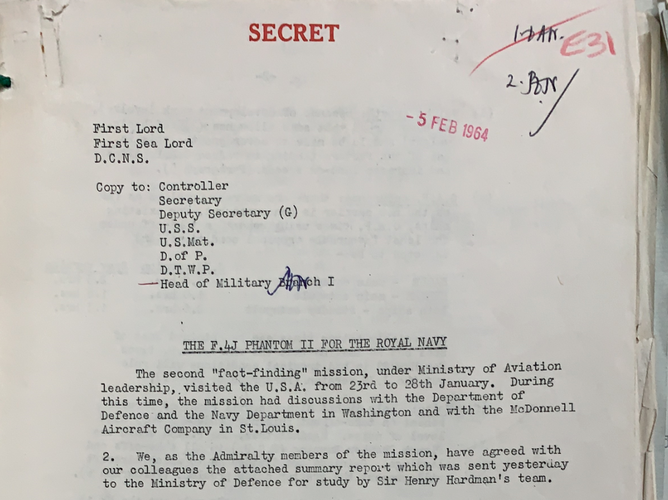You are using an out of date browser. It may not display this or other websites correctly.
You should upgrade or use an alternative browser.
You should upgrade or use an alternative browser.
Planned UK carrier order of battle 1975
- Thread starter uk 75
- Start date
orlovsky
I really should change my personal text
- Joined
- 28 May 2016
- Messages
- 268
- Reaction score
- 570
With regard to the Invincibles and the Sea Harrier. The original plan was for 800, 801 and 802 FAA squadrons to be frontline squadrons with five aircraft each but the reformation of 802 was effectively cancelled by the 1981 Nott review. Following the Falklands, 800 and 801 seem to have deployed with eight aircraft each, which would have produced an active frontline of sixteen aircraft versus fifteen under the original plan. I have always assumed that 899 Headquarters Squadron was intended to provide a shadow squadron that could be mobilised in wartime when the third ship became available, just as the USN reserve air wings were intended to do and as actually happened during the Falklands (producing 809 Squadron). This would also have matched the shadow squadron model used by the RAF.
So this means essentially one is a reserve carrier with a "reserve" air wing by another name? On the manpower side, this requires only two crews - ie 2x1000 for the Invincibles?
Would it have made sense to operate a fleet of 3 CVAs in that way? Probably almost as difficult to keep one carrier forward deployed as for a 2 carrier fleet...
SSgtC
ACCESS: Top Secret
- Joined
- 13 July 2020
- Messages
- 1,241
- Reaction score
- 2,891
I'm not sure if the UK's manpower situation would have allowed a 3 CVA force. Not without cuts elsewhere anyway. You need at least 2.5 crews to maintain a proper rotation and allow your personnel a proper amount of shore time between deployments. Otherwise you're constantly cross decking and that only makes your manpower situation worse. Even with that, you end up cross decking some personnel and they go on back to back deployments. The USN had that problem in Vietnam. The operational tempo was too high forcing the Navy to pull personnel and in some instances, entire squadrons of aircraft, from an inbound carrier and assign them to an outbound carrier to fill gaps. And that was even with conscription.With regard to the Invincibles and the Sea Harrier. The original plan was for 800, 801 and 802 FAA squadrons to be frontline squadrons with five aircraft each but the reformation of 802 was effectively cancelled by the 1981 Nott review. Following the Falklands, 800 and 801 seem to have deployed with eight aircraft each, which would have produced an active frontline of sixteen aircraft versus fifteen under the original plan. I have always assumed that 899 Headquarters Squadron was intended to provide a shadow squadron that could be mobilised in wartime when the third ship became available, just as the USN reserve air wings were intended to do and as actually happened during the Falklands (producing 809 Squadron). This would also have matched the shadow squadron model used by the RAF.
So this means essentially one is a reserve carrier with a "reserve" air wing by another name? On the manpower side, this requires only two crews - ie 2x1000 for the Invincibles?
Would it have made sense to operate a fleet of 3 CVAs in that way? Probably almost as difficult to keep one carrier forward deployed as for a 2 carrier fleet...
- Joined
- 16 April 2008
- Messages
- 9,608
- Reaction score
- 14,504
I admit that I do not understand the operational logic. The US Navy assumed that it could surge 80-85% of the carriers in conflict. With 3, you don't get even numbers, but about half the time, you have a third carrier with no (or just an improvised) air group?
I assume they would have deployed 899 Squadron (the training unit) if they needed a third air group. It would have taken so much effort to make a third carrier ready for action that reorienting that squadron would probably have been the least hard thing they needed to do.
orlovsky
I really should change my personal text
- Joined
- 28 May 2016
- Messages
- 268
- Reaction score
- 570
What was the intended design life of the Invincible's?
Hobbs, The British Carrier Strike Fleet after 1945, gives them as "twenty to twenty-five years with a planned interval between refits of about four years".
Another tidbit that was new to me: While the complement started at about 950, "by 1997, however, the scheme of complement for the class had risen to 1250".
orlovsky
I really should change my personal text
- Joined
- 28 May 2016
- Messages
- 268
- Reaction score
- 570
The other thing I want to check is the air-groups- did the number of air-groups fall with the number of carriers in 1963 to become three active fleet carriers and two air groups? I need to check.
I have been looking into the RAN Report on the essex class carrier. The file contains several other quite interesting documents, this is on p 159:
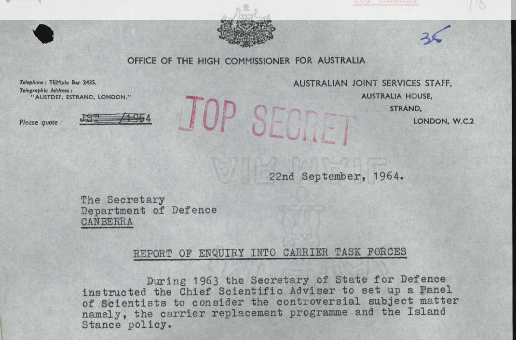
p 161:

Did the study precede the decision to go down to 3 CVAs - I thought that was around mid 1963? The document from September 1964 does not mention a decision to reduce the number below 4.
Volkodav
I really should change my personal text
- Joined
- 28 March 2014
- Messages
- 750
- Reaction score
- 1,271
Another interesting topic.
It raises one question that keeps coming back, could even a small number of Phantoms been successfully operated from Hermes if upgraded with appropriate facilities?
Some sources say yes, some say no and I believe there may have been issues with WOD as the steam required to operate sufficiently powerful cats, may have reduced the speed she would be capable of while launching. If this was the case could new boilers capable of producing sufficient steam for cats and propulsion have been fitted as part of a Phantom upgrade?
Would the recently reconstructed Vic have been a better option? That is assuming she could accept the other mods required for Phantom?
It raises one question that keeps coming back, could even a small number of Phantoms been successfully operated from Hermes if upgraded with appropriate facilities?
Some sources say yes, some say no and I believe there may have been issues with WOD as the steam required to operate sufficiently powerful cats, may have reduced the speed she would be capable of while launching. If this was the case could new boilers capable of producing sufficient steam for cats and propulsion have been fitted as part of a Phantom upgrade?
Would the recently reconstructed Vic have been a better option? That is assuming she could accept the other mods required for Phantom?
- Joined
- 15 July 2007
- Messages
- 4,889
- Reaction score
- 4,553
Another interesting topic.
It raises one question that keeps coming back, could even a small number of Phantoms been successfully operated from Hermes if upgraded with appropriate facilities?
Some sources say yes, some say no and I believe there may have been issues with WOD as the steam required to operate sufficiently powerful cats, may have reduced the speed she would be capable of while launching. If this was the case could new boilers capable of producing sufficient steam for cats and propulsion have been fitted as part of a Phantom upgrade?
Would the recently reconstructed Vic have been a better option? That is assuming she could accept the other mods required for Phantom?
In terms of catapult, yes at modest weights and a light natural WOD plus steaming. Then F4K could successfully launch.
Recovery seems tight, though replacement of arrestor gear with the latest then system ought to ease this. Very tight on bolters I suspect.
Lifts are a problem, centerline aft lift needs the nose folded, deck edge forward is potentially good enough for a tight unfolded nose arrangement.
Weights would be limited, Fighter operations only I suspect.
Hanger width limits internal storage to two folded wing aircraft abrest.
Victorious has a dry forward lift, better ability to keep above 25kts, better recovery zone. Hidden benefits range from more internal facilities, to more capable CDS.
orlovsky
I really should change my personal text
- Joined
- 28 May 2016
- Messages
- 268
- Reaction score
- 570
I hope I'm not drifting too far off-topic: The plan for Hermes was one 151ft and one 176ft catapult. The latter would allow for 1.8 hrs CAP in nil wind tropics, probably at about 48k lbs launch weight.
The actual performance of the F-4K was not so good. From the launch speeds, I get something like 30 kts WOD (vs 25 ship speed) in nil wind tropics at only 44k lbs. The tanking requirement for longer CAP missions from Hermes may have been a dealbreaker.
(Oddly enough, the F-4B with the longer nose strut would have given a similar or slightly better performance, so the hopes for the Spey did not materialise.)
On landing, the pullout distance used on Ark Royal would not fit on Hermes, but I do not know how much that would affect landing weights.
The actual performance of the F-4K was not so good. From the launch speeds, I get something like 30 kts WOD (vs 25 ship speed) in nil wind tropics at only 44k lbs. The tanking requirement for longer CAP missions from Hermes may have been a dealbreaker.
(Oddly enough, the F-4B with the longer nose strut would have given a similar or slightly better performance, so the hopes for the Spey did not materialise.)
On landing, the pullout distance used on Ark Royal would not fit on Hermes, but I do not know how much that would affect landing weights.
I recently learned that Centaur-class carriers "only" had 76 000 hp, when Victorious and the Audacious class were 120 000 hp or more. This impact the ability to divert steam from the power plant to the catapults.
Less steam = slower carrier = less wind over the deck
Less steam = slower carrier = less wind over the deck
- Joined
- 15 July 2007
- Messages
- 4,889
- Reaction score
- 4,553
Hermes had just two sets of Capital Ship Plant.I recently learned that Centaur-class carriers "only" had 76 000 hp, when Victorious and the Audacious class were 120 000 hp or more. This impact the ability to divert steam from the power plant to the catapults.
Less steam = slower carrier = less wind over the deck
Victorious had three sets.
Hermes had a lengthened catapult after refit, can't remember the lengths now. But it is mentioned somewhere here.
Both should make 25kts Deep and Dirty.
- Joined
- 22 April 2012
- Messages
- 2,258
- Reaction score
- 2,309
The attached were posted at the navweaps forum by beksh and discuss the use of the F-4 Phantom from Hermes and Eagle. The report they are from dates to January 1964 and is therefore from the period after the July 1963 decision that Victorious would be withdrawn without replacement in 1971 and Ark Royal would be replaced by CVA-01 in 1972, leaving Hermes and Eagle in service as the legacy carriers in a fleet totalling three ships. The report is interesting as it confirms a plan to operate the Phantom from Hermes and shows perceived operational advantages in using the Spey rather than the J-79 in the Phantom were identified very early on.
Parliamentary discussion of the use of Phantoms from Hermes was discussed in this thread.
I think the study referenced in the Australian papers posted by orlovsky is the 1962/63 'Enquiry in to Naval Forces and Anti-Submarine Warfare Study' as it was chaired by Solly Zuckerman as Chief Scientific advisor and had a panel of independent academics (Dr J.C. Kendrew as Deputy Chairman, Professor H. Bondi, Sir E. Bullard, Sir W. Cook, Dr M.N. Hill and Professor R.V. Jones), matching the context given in the Australian document. Therefore, the study itself predates the decision to reduce the size of the carrier fleet but the document referencing it is fourteen months after the decision was taken, and publicised, to reduce the carrier fleet to three units.
The proposed deletion of Ark Royal rather than Hermes was driven by the belief that she would need a very large and expensive refit to get her beyond 1972. I can't help thinking that Hermes being smaller and having a smaller air wing would have added to her relative cost advantage versus Ark Royal, something that would have been important given the ongoing debates around the future of the carrier fleet.
Parliamentary discussion of the use of Phantoms from Hermes was discussed in this thread.
I think the study referenced in the Australian papers posted by orlovsky is the 1962/63 'Enquiry in to Naval Forces and Anti-Submarine Warfare Study' as it was chaired by Solly Zuckerman as Chief Scientific advisor and had a panel of independent academics (Dr J.C. Kendrew as Deputy Chairman, Professor H. Bondi, Sir E. Bullard, Sir W. Cook, Dr M.N. Hill and Professor R.V. Jones), matching the context given in the Australian document. Therefore, the study itself predates the decision to reduce the size of the carrier fleet but the document referencing it is fourteen months after the decision was taken, and publicised, to reduce the carrier fleet to three units.
The proposed deletion of Ark Royal rather than Hermes was driven by the belief that she would need a very large and expensive refit to get her beyond 1972. I can't help thinking that Hermes being smaller and having a smaller air wing would have added to her relative cost advantage versus Ark Royal, something that would have been important given the ongoing debates around the future of the carrier fleet.
Attachments
Last edited:
orlovsky
I really should change my personal text
- Joined
- 28 May 2016
- Messages
- 268
- Reaction score
- 570
This below is the title given in the RAN file (I am not sure to what extent excerpts should be posted here?) and it is the Kendrew report, though there is also a lot of material on ASW which looks like it is from a separate study - but that may be a wrong impression.
So the "during 1963" should actually be 1962/63? That would give a coherent timeline.
And that someone forgot to update the carrier figure would be so typical for bureaucracies and their papers.

So the "during 1963" should actually be 1962/63? That would give a coherent timeline.
And that someone forgot to update the carrier figure would be so typical for bureaucracies and their papers.
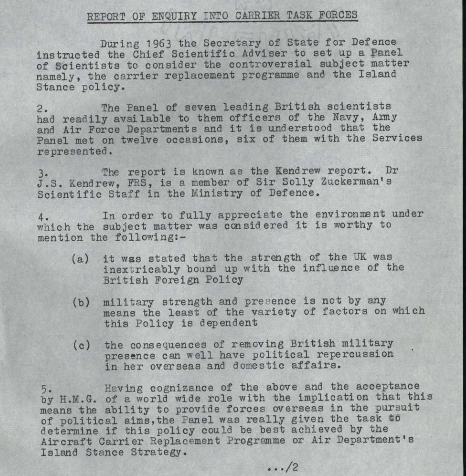
SSgtC
ACCESS: Top Secret
- Joined
- 13 July 2020
- Messages
- 1,241
- Reaction score
- 2,891
One thing to keep in mind is how fast a carrier could go during flight ops when steam is being diverted to the cats. For instance, the Essex class could only maintain 19 knots while conducting flight operations because of the amount of steam that was being diverted to the cats. The Midway class could maintain 23 during flight operations due to being able to generate more steam. With Hermes I would be surprised if she was able to maintain any more than 15 knots during flight operations due to diversion of steam from the turbines to the cats.I recently learned that Centaur-class carriers "only" had 76 000 hp, when Victorious and the Audacious class were 120 000 hp or more. This impact the ability to divert steam from the power plant to the catapults.
Less steam = slower carrier = less wind over the deck
Edit to add: this only applies during continous flight operations. You could keep the ship moving faster by limiting the number of launches or by by staggering them to allow the ship to regain some of the speed lost during the previous launch
- Joined
- 15 July 2007
- Messages
- 4,889
- Reaction score
- 4,553
Hermes plant was improved over the other Centaurs to a total of 80,000shp. Rated at over 28kts D&D 6 months out in the tropics if I recall correctly.
I note that in context of P1154 handling the landing with PCB is "solvable".
I note that in context of P1154 handling the landing with PCB is "solvable".
SSgtC
ACCESS: Top Secret
- Joined
- 13 July 2020
- Messages
- 1,241
- Reaction score
- 2,891
Oh they do! Even the Nimitz class can only maintain about 25-27 knots during flight opsAnd of course nuclear carriers simply don't care about such issues...
orlovsky
I really should change my personal text
- Joined
- 28 May 2016
- Messages
- 268
- Reaction score
- 570
From a layman: Both aircraft have different characteristics. For launch speeds, at 50k lbs, the Buccaneer had a minimum launch speed of about 130 kts, the F-4K of 137-140 kts. Bucc from Hermes with existing catapults was limited to about 45k lbs, the F-4K probably a bit below that.
Landing speeds were pretty similar.
F-4K launched in afterburner, requiring water cooled jbds and a special arrangement to keep the flightdeck from melting.
You could have operated F-4s from Hermes or the Clemenceau class, but with serious restrictions. Some of that could be improved by carrier refits like the 176 ft catapult.
Landing speeds were pretty similar.
F-4K launched in afterburner, requiring water cooled jbds and a special arrangement to keep the flightdeck from melting.
You could have operated F-4s from Hermes or the Clemenceau class, but with serious restrictions. Some of that could be improved by carrier refits like the 176 ft catapult.
Also from another layman, Buccaneer had boundary layer control, which effectively bled air from the engines, which was then fed through vents in the wings. This effectively enlarges the wing area of the aircraft and improves its take off, landing and low level performance.
Volkodav
I really should change my personal text
- Joined
- 28 March 2014
- Messages
- 750
- Reaction score
- 1,271
I suppose the irony with Hermes size, hence limited number of aircraft, is that she wouldn't ever be launching massed strikes so there wouldn't be volume of steam required over extended periods.
The catch 22 with Hermes is logistically it would have made sense for her to operate Phantoms only, however the limited weights for launch and recovery, would have limited the F-4s effectiveness in the strike role.
The catch 22 with Hermes is logistically it would have made sense for her to operate Phantoms only, however the limited weights for launch and recovery, would have limited the F-4s effectiveness in the strike role.
Volkodav
I really should change my personal text
- Joined
- 28 March 2014
- Messages
- 750
- Reaction score
- 1,271
The RN apparently did a study on an all A-4 Skyhawk group, I believe the number was 28 or 30 but will need to find and check the reference (if I can ever remember where I read it).To be honest I don’t see how you improve on the historic Hermes air group of 12 Sea Vixen, 7 Buccaneers, 5 Gannets and 5 Wessex...
I have wondered how a Jaguar M air group would have done. More to the point how a Sea Jaguar FRS1 then F/A2 using Sea Harrier avionics, would have done flying into the 80s or potentially 90s on Hermes, Vic and Eagle.
- Joined
- 15 July 2007
- Messages
- 4,889
- Reaction score
- 4,553
So had the Jaguar M worked out better it might have delivered such a capability.The RN apparently did a study on an all A-4 Skyhawk group, I believe the number was 28 or 30 but will need to find and check the reference (if I can ever remember where I read it).To be honest I don’t see how you improve on the historic Hermes air group of 12 Sea Vixen, 7 Buccaneers, 5 Gannets and 5 Wessex...
I have wondered how a Jaguar M air group would have done. More to the point how a Sea Jaguar FRS1 then F/A2 using Sea Harrier avionics, would have done flying into the 80s or potentially 90s on Hermes, Vic and Eagle.
But this does remind me of a curious question I still have. Why is there no supersonic version of the Skyhawk?
As this would solve this conundrum, and sell quite well.
orlovsky
I really should change my personal text
- Joined
- 28 May 2016
- Messages
- 268
- Reaction score
- 570
I never new that.
From the SAC, for example http://www.alternatewars.com/SAC/F4H-1_SAC_-_1_February_1963.pdf
Made about 20 kts difference in approach speed.

The Jaguar M was a complete dog, really. That was the general feeling as of spring 1972, after the trials onboard Foch.
Then again, it was with the pretty weak Adour mk.102. You british updated the Jaguar with the -104 and -106 variants - and things got much better obviously, with 40% more thrust !
The French by contrast stuck with the Adour 102 all the way until 2007 and retirement, including in Africa (!) with very heavy AS-37 missiles (!!). The irony !
And rinse, repeat, for avionics. British Jaguars were top notch, French Jaguars were... miserable. First GPS receivers onboard were hand-held kits strapped with tape: no kidding.
Note that French trials of Jaguar M also noted the need for a larger wing, and this instantly doomed the aircraft, as no money was forthcoming for that.
One can wonder how good would be a Jaguar M with Mk.104 Adours and the standard wing.
The Jaguar wasn't build for manoeuverability either, but chasing Soviet naval bombers doesn't requires it.
Then again, it was with the pretty weak Adour mk.102. You british updated the Jaguar with the -104 and -106 variants - and things got much better obviously, with 40% more thrust !
The French by contrast stuck with the Adour 102 all the way until 2007 and retirement, including in Africa (!) with very heavy AS-37 missiles (!!). The irony !
And rinse, repeat, for avionics. British Jaguars were top notch, French Jaguars were... miserable. First GPS receivers onboard were hand-held kits strapped with tape: no kidding.
Note that French trials of Jaguar M also noted the need for a larger wing, and this instantly doomed the aircraft, as no money was forthcoming for that.
One can wonder how good would be a Jaguar M with Mk.104 Adours and the standard wing.
The Jaguar wasn't build for manoeuverability either, but chasing Soviet naval bombers doesn't requires it.
- Joined
- 27 September 2006
- Messages
- 6,417
- Reaction score
- 6,818
Ark Royal rather than Eagle became the sole RN carrier for the 70s because it refitted before Eagle. Eagle's refit would not have been completed until 1972 or so, which was why it was cancelled. The Tories came into power in 1970 and re examined the carrier situation. Significantly the only change they made was to extend Ark's life from mid to late 70s.
This was based on the Soviet threat as it looked in 1970. The supersonic Backfire had yet to appear and the Tu22 Blinder was only around in small numbers. ASW was thus the main role for the RN in NATO.
Hermes and Bulwark would be able operate significant numbers of Seakings until the new Command Cruisers appeared.
It is a shame that Eagle rather than Ark was not in the right refit cycle but we would still only have had one operational carrier in the 70s. We were fortunate to have this capability with Phantoms and Bucs.
The CVF programme in a UK in rather better economic shape than the 60s and 70s has shown how difficult a conventional carrier programme would have been. Invincible took long enough to build as it was.
This was based on the Soviet threat as it looked in 1970. The supersonic Backfire had yet to appear and the Tu22 Blinder was only around in small numbers. ASW was thus the main role for the RN in NATO.
Hermes and Bulwark would be able operate significant numbers of Seakings until the new Command Cruisers appeared.
It is a shame that Eagle rather than Ark was not in the right refit cycle but we would still only have had one operational carrier in the 70s. We were fortunate to have this capability with Phantoms and Bucs.
The CVF programme in a UK in rather better economic shape than the 60s and 70s has shown how difficult a conventional carrier programme would have been. Invincible took long enough to build as it was.
Through another thread at AH.com I found the exact moment and reason why Ark Royal was Phantomized and lasted until 1978, rather than Eagle.
Eagle ran aground in October 1970 and the damage was to the transmissions and propellers. While the later could be changed, the former could not be corrected and as such, Eagle "limped on" until early 1972 when it was retired.
That grounding was really the last nail in Eagle coffin. I'll try to find the link.
Eagle ran aground in October 1970 and the damage was to the transmissions and propellers. While the later could be changed, the former could not be corrected and as such, Eagle "limped on" until early 1972 when it was retired.
That grounding was really the last nail in Eagle coffin. I'll try to find the link.
orlovsky
I really should change my personal text
- Joined
- 28 May 2016
- Messages
- 268
- Reaction score
- 570
It is a matter of priorities, and the carrier programme collided foremeost with SSBN/SSN. You'd probably get a medium fleet carrier for the price of two SSNs, but in the cold war setting, SSNs were probably the better asset. So the RN got Phantoms and Buccaneers in before Polaris, but no new carrier. Around 2000, the carrier is more interesting.
In essence, the french story is the same, just a slightly different timeline and focus ship/aircraft. They got their medium carriers, but when seroius refits and a new air group were due, around 1975/80, they were also right in the middle of the SSBN/SSN programme. So austere refit, no new fighters, no new AEW. In the 1990s, slow build of CDG, but around 2000, Rafales and Hawkeyes.
In essence, the french story is the same, just a slightly different timeline and focus ship/aircraft. They got their medium carriers, but when seroius refits and a new air group were due, around 1975/80, they were also right in the middle of the SSBN/SSN programme. So austere refit, no new fighters, no new AEW. In the 1990s, slow build of CDG, but around 2000, Rafales and Hawkeyes.
Eagle grounding, 1970 (bottom of the post).
 www.secretprojects.co.uk
www.secretprojects.co.uk
What if there had been a Falklands type conflict at another pivotal point in history?
There are a number of discussions across various topics that got me thinking of the changes to the post Nott Review RN because of the lessons learned due to the Falklands War and what would have happened had that, or a similar conflict, occurred at various points in history, post WWII. The same...
SSgtC
ACCESS: Top Secret
- Joined
- 13 July 2020
- Messages
- 1,241
- Reaction score
- 2,891
The USN ran into this problem as well. They were building a total of 41 SSBNs. But they also wanted to order a new nuclear powered carrier every other year. Guess which program got cut? First the carrier program was pushed to one carrier every 3 years. Then one every 4. Then one every 5 years.It is a matter of priorities, and the carrier programme collided foremeost with SSBN/SSN. You'd probably get a medium fleet carrier for the price of two SSNs, but in the cold war setting, SSNs were probably the better asset. So the RN got Phantoms and Buccaneers in before Polaris, but no new carrier. Around 2000, the carrier is more interesting.
In essence, the french story is the same, just a slightly different timeline and focus ship/aircraft. They got their medium carriers, but when seroius refits and a new air group were due, around 1975/80, they were also right in the middle of the SSBN/SSN programme. So austere refit, no new fighters, no new AEW. In the 1990s, slow build of CDG, but around 2000, Rafales and Hawkeyes.
orlovsky
I really should change my personal text
- Joined
- 28 May 2016
- Messages
- 268
- Reaction score
- 570
True, they also did not get all the F-14s they wanted. I think the frontline F-14s were cut from 24 to 14 per carrier.
And if the US Navy does not get all the new shiny toys, you know that things are tight.
And if the US Navy does not get all the new shiny toys, you know that things are tight.
The USN ran into this problem as well. They were building a total of 41 SSBNs. But they also wanted to order a new nuclear powered carrier every other year. Guess which program got cut? First the carrier program was pushed to one carrier every 3 years. Then one every 4. Then one every 5 years.It is a matter of priorities, and the carrier programme collided foremeost with SSBN/SSN. You'd probably get a medium fleet carrier for the price of two SSNs, but in the cold war setting, SSNs were probably the better asset. So the RN got Phantoms and Buccaneers in before Polaris, but no new carrier. Around 2000, the carrier is more interesting.
In essence, the french story is the same, just a slightly different timeline and focus ship/aircraft. They got their medium carriers, but when seroius refits and a new air group were due, around 1975/80, they were also right in the middle of the SSBN/SSN programme. So austere refit, no new fighters, no new AEW. In the 1990s, slow build of CDG, but around 2000, Rafales and Hawkeyes.
Damn, never realized that. At a rate of one every two years, from 1960 to 2020, they could have build 30 CVN ! instead - 1*Enterprise, 10*Nimitz, 1*Ford. Twelve, 2.5 times less !
- Joined
- 2 January 2006
- Messages
- 659
- Reaction score
- 283
No Supersonic Skyhawk, because the USN were developing the A-7 Corsair instead and other new bigger more powerful naval jets for big super carriers.So had the Jaguar M worked out better it might have delivered such a capability.The RN apparently did a study on an all A-4 Skyhawk group, I believe the number was 28 or 30 but will need to find and check the reference (if I can ever remember where I read it).To be honest I don’t see how you improve on the historic Hermes air group of 12 Sea Vixen, 7 Buccaneers, 5 Gannets and 5 Wessex...
I have wondered how a Jaguar M air group would have done. More to the point how a Sea Jaguar FRS1 then F/A2 using Sea Harrier avionics, would have done flying into the 80s or potentially 90s on Hermes, Vic and Eagle.
But this does remind me of a curious question I still have. Why is there no supersonic version of the Skyhawk?
As this would solve this conundrum, and sell quite well.
Naval Jaguar probably would have worked a lot better if the British had been involved more but as the death knell had been sounded for the Carrier fleet in 1966 there was active involvement bar carrier testing ground trials. As you know the 583 was envisaged to be a next generation VG replacement for the Sea Vixen with a secondary strike role, matching the capabilities of the big heavy 50s Phantom with a smaller, lighter more capable design using 60s technology. The AFVG would probably evolved into a 583 follow on and replace the Phantom & Buccaneer in due course during the 70's. With the UK out of the game, the US focusing of big Super Carriers, there was no driving force and therefore funding for smaller aircraft carrier aircraft development.
Similar threads
-
-
UK replenishment ship/helicopter carrier studies circa 1980
- Started by Triton
- Replies: 14
-
CVA-01 - What was the RN carrier plan 1966-1976
- Started by Thorvic
- Replies: 138
-
-

